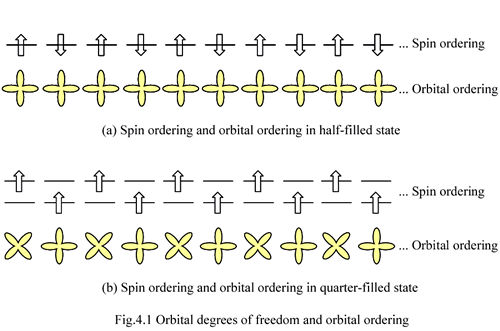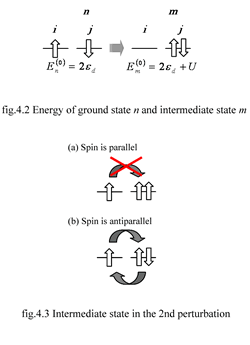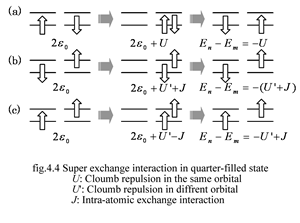 |
||||||||||
Interaction in Orbital Ordering
4.1 Super Exchange Interaction and Orbital Ordering
Super exchange interaction is one of the interactions which make orbital ordering. Here let us explain the relationship between orbital degrees of freedom and super exchange interaction. Let us discuss the following 2 cases as an example.
- Half-filled state (the orbital degrees of freedom is same with the number of electron.)
- Quarter-filled state (the orbital degrees of freedom is doubled with the number of electron)
Half-filled state realizes orbital ferro and magnetic antiferro state [Fig.4.1 (a)]. Quarter-filled state realizes orbital antiferro and magnetic ferro state [Fig.4.1 (b)]. That is to say, orbital degrees of freedom determine the spin ordering. In the following sections, we will discuss the reasons why the orbital ordering controls spin ordering.
4.2 Super Exchange Interaction
Firstly, let us explain perturbation, which is neccesarry to understand super exchange interaction. When we take the perturbation into account, Hamiltonian: H is expressed as follows.
![]() (H0: Hamiltonian in the no perturbation part, V: Correction by perturbation)
(H0: Hamiltonian in the no perturbation part, V: Correction by perturbation)
Here, Schrodinger equation in the no perturbation is expressed as follows.
![]()
Therefore All energy including perturbation part: En and wave function is expressed as follows.

As we express energy in the 2nd perturbation as ![]() , it is as follows.
, it is as follows.
@
![]() is probability amplitude from l to k. We define the probability amplitude of transfering the electron as t.
is probability amplitude from l to k. We define the probability amplitude of transfering the electron as t.
 As we assume n as ground state, m as intermediate state has Cloumb interaction: U because 2 electron exist in the same orbital. Therefore Em is larger than En [fig.4.2]. Therefore 2nd perturbation decreases the energy in the ground state. Next, let us consider the case in the half-filled state. When one electron localizes at each atom, it is stable state. When 2 electron exist in each atom, this state needs higher energy than one electron case. However when we consider the 2nd perturbation energy indicated in fig.4.3 (b), it is expressed as follows. (fig.4.3 (a) is not permitted, because 2 spin are parallel.)
As we assume n as ground state, m as intermediate state has Cloumb interaction: U because 2 electron exist in the same orbital. Therefore Em is larger than En [fig.4.2]. Therefore 2nd perturbation decreases the energy in the ground state. Next, let us consider the case in the half-filled state. When one electron localizes at each atom, it is stable state. When 2 electron exist in each atom, this state needs higher energy than one electron case. However when we consider the 2nd perturbation energy indicated in fig.4.3 (b), it is expressed as follows. (fig.4.3 (a) is not permitted, because 2 spin are parallel.)
@![]()
Therefore the state decreases the energy. That is to say, this interaction realizes antiferromagnetic state. And this is caused by movement of electron. When the interaction between the same orbital make the spins antiparallel, we call it "super exchange interaction."
4.3 Ferromagnetic Super Exchange Interaction
Super exchange interaction is introduced by the 2nd perturbation of electron transfer integral.  It is important that the transfer integral depends on orbital. When we consider quater-fill state, following 4 process is proposed [fig.4].
It is important that the transfer integral depends on orbital. When we consider quater-fill state, following 4 process is proposed [fig.4].
Interaction in (a) and (b) is antiferromagnetic.
Interaction in (c) is ferromagnetic. When we compare the (a) to (c), energy in (c) is lowest. Therefore in case of quater-filled state, ferromagnetic spin order and antiferro orbital order is realized. We call it "ferromagnetic super exchange interaction."